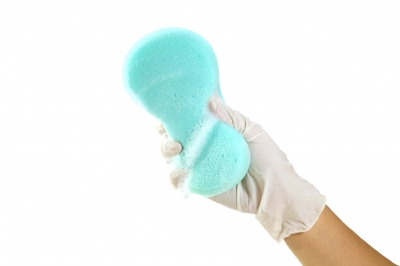Chlorine Bleach and Mold Clean Up, the controversy!
http://www.airdetectives.ca/chlorine.html
A myth exists concerning the use and "effectiveness" of Chlorine bleach (sodium hypochlorite) in the remediation of a mold problem. Mold remediation involves the removal and or cleans up and restoration of mold contaminated building materials.

To use bleach or not to use bleach?
Opposing Views and Confusion
Chlorine bleach, commonly referred to as laundry bleach, is generally perceived to be an "accepted and answer-all" biocide to abate mold in the remediation processes. Well-intentioned recommendations of the Environmental Protection Agency (EPA) and other federal, state and local agencies are perpetuating that belief. Confusing the issue is one federal agency, the Occupational Health and Safety Administration (OSHA), taking an opposing point of view by NOT recommending the use of Chlorine bleach as a routine practice in mold remediation.
Does Bleach Really Kill mold?
Will Chlorine bleach kill mold or not-yes or no? The answer is yes, but with a caveat. That answer comes from The Clorox Company, Oakland CA, manufacturer and distributor of Ultra Clorox Regular Bleach. The company's correspondence to MicrobeGuard stated that their Tech Center studies supported by independent laboratories show that "…3/4 cup of Clorox liquid bleach per gallon of water will be effective on hard, non-porous surfaces against… Aspergillus Niger and Trichophyton mentagrophytes (Athlete's Foot Fungus)". Whether or not Chlorine bleach kills other molds and fungi, the company did not say. The words "hard, non-porous surfaces" present the caveat. Mold remediation involves the need to disinfect wood and wood-based building materials, all of which are porous materials. Thus, Chlorine bleach should not be used in mold remediation as confirmed by OSHA's mold Remediation/Clean-Up Methods guidelines. The use of bleach as a mold disinfectant is best left to kitchen and bathroom countertops, tubs and shower glass, etc.
Why Chlorine Bleach is NOT Recommended for mold Remediation
Chlorine bleach (sodium hypochlorite) is corrosive and that fact is stated on the product label. Yet the properties of Chlorine bleach prevent it from "soaking into" wood-based building materials to get at the deeply embedded mycilia (roots) of mold. The object to killing mold is to kill its "roots". Reputable mold remediation contractors use appropriate products that effectively disinfect salvageable mold infected wood products. Beware of any mold inspector or a mold Remediation Company that recommends or uses Chlorine bleach for mold clean up on wood-based building materials.
Chlorine Bleach Is Active Ingredient in New mold & Mildew Products
The appearance of new mold and mildew household products on store shelves is on the rise. Most are dilute solutions of laundry bleach. The labels on these mold and mildew products state that they are for use on (again) hard, non-porous surfaces and not for wood-based materials. Instructions where not to apply the products are varied. A few examples where the branded products should not be applied include wood or painted surfaces, aluminum products, metal (including stainless steel), faucets, marble, natural stone, and, of course, carpeting, fabrics and paper. One commercial mold and mildew stain remover even specifically states it should not be applied to porcelain or metal without immediate rinsing with water and that the product isn't recommended for use on Formica or vinyl.
Caveat Emptor!
Before purchasing a mold and mildew product, read and fully understand the advertised purpose of that product - and correctly follow the use instructions of a purchased product. The labeling claims on these new products can be confusing - some say their product is a mold and mildew remover while another says their product is a mildew stain remover and yet others make similar 'ambiguous' claims. Make double sure that the product satisfies your intended need on the surface to which it is to be applied. If your intention is to kill mold, make sure the product does exactly that and follow the directions for usage. Consumers may find that mixing their own diluted bleach solution will achieve the same results as any of the new mold and mildew products - keep in mind that the use of Chlorine bleach is not for use on mold infected wood products including wall board, ceiling tiles, wall studs, fabric, paper products, etc.
Conclusion
Laundry bleach is not an effective mold killing agent for wood-based building materials and NOT EFFECTIVE in the mold remediation process. OSHA is the first federal agency to announce a departure from the use of Chlorine bleach in mold remediation. In time, other federal agencies are expected to follow OSHA's lead. The public should be aware, however, that Chlorine bleach solution IS an effective sanitizing product that kills mold on hard surfaces and neutralizes indoor mold allergens that trigger allergies.
The original can be found at: http://www.airdetectives.ca/chlorine.html
